Chapter 2B. Regulatory Signs
Section 2B.34 DO NOT ENTER Sign (R5-1)
Standard:
The DO NOT ENTER (R5-1) sign (see Figure 2B-9) shall be used where
traffic is prohibited from entering a restricted roadway.
Figure 2B-9 Traffic Prohibition Signs
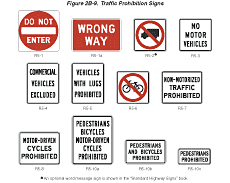
Guidance:
The DO NOT ENTER sign, if used, should be placed directly in view
of a road user at the point where a road user could wrongly enter
a divided highway, one-way roadway, or ramp (see Figure 2B-10).
The sign should be mounted on the right side of the roadway, facing
traffic that might enter the roadway or ramp in the wrong direction.
If the DO NOT ENTER sign would be visible to traffic to which it does not apply, the sign should be turned away from, or shielded from, the view of that traffic.
Option:
The DO NOT ENTER sign may be installed where it is necessary to
emphasize the one-way traffic movement on a ramp or turning lane.
A second DO NOT ENTER sign on the left side of the roadway may be used, particularly where traffic approaches from an intersecting roadway (see Figure 2B-10).
Figure 2B-10 Example of Wrong-Way Signing for a Divided Highway with a Median Width of 9 m (30 ft) or Greater

Section 2B.35 WRONG WAY Sign (R5-1a)
Option:
The WRONG WAY (R5-1a) sign (see Figure 2B-9) may be used as a supplement
to the DO NOT ENTER sign where an exit ramp intersects a crossroad
or a crossroad intersects a one-way roadway in a manner that does
not physically discourage or prevent wrong-way entry (see Figure
2B-10).
Guidance:
If used, the WRONG WAY sign should be placed at a location along
the exit ramp or the one-way roadway farther from the crossroad
than the DO NOT ENTER sign (see Section
2E.50).
Section 2B.36 Selective Exclusion Signs
Support:
Selective Exclusion signs (see Figure 2B-9) give notice to road
users that State or local statutes or ordinances exclude designated
types of traffic from using particular roadways or facilities.
Standard:
If used, Selective Exclusion signs shall clearly indicate the type
of traffic that is excluded.
Support:
Typical exclusion messages include:
- No Trucks (R5-2);
- NO MOTOR VEHICLES (R5-3);
- COMMERCIAL VEHICLES EXCLUDED (R5-4);
- TRUCKS (VEHICLES) WITH LUGS PROHIBITED (R5-5);
- No Bicycles (R5-6);
- NON-MOTORIZED TRAFFIC PROHIBITED (R5-7);
- MOTOR-DRIVEN CYCLES PROHIBITED (R5-8); and
- Hazardous Material Prohibited (R14-3) (see Section 2B.52).
Option:
Appropriate combinations or groupings of these legends into a single
sign, such as PEDESTRIANS BICYCLES MOTOR-DRIVEN CYCLES PROHIBITED
(R5-10a), or PEDESTRIANS AND BICYCLES PROHIBITED (R5-10b) may be
used.
Guidance:
If an exclusion is governed by vehicle weight, a Weight Limit sign
(see Section 2B.49) should
be used instead of a Selective Exclusion sign.
The Selective Exclusion sign should be placed on the right side of the roadway at an appropriate distance from the intersection so as to be clearly visible to all road users turning into the roadway that has the exclusion. The PEDESTRIANS PROHIBITED (R5-10c) or No Pedestrian Crossing (R9-3a) sign should be installed so as to be clearly visible to pedestrians at a location where an alternative route is available.
Option:
The NO TRUCKS (R5-2a) sign may be used as an alternate to the No
Trucks (R5-2) symbol sign.
The PEDESTRIANS PROHIBITED (R5-10c) or No Pedestrian Crossing (R9-3a) sign may also be used at underpasses or elsewhere where pedestrian facilities are not provided.
Section 2B.37 ONE WAY Signs (R6-1, R6-2)
Standard:
Except as noted in the Option, the ONE WAY (R6-1 or R6-2) sign (see
Figure 2B-11) shall be used to indicate streets or roadways upon
which vehicular traffic is allowed to travel in one direction only.
Figure 2B-11 ONE WAY and Divided Highway Crossing Signs

ONE WAY signs shall be placed parallel to the one-way street at all alleys and roadways that intersect one-way roadways as shown in Figures 2B-12 through 2B-15.
Figure 2B-12 Examples of Locations of ONE WAY Signs (2 Sheets)
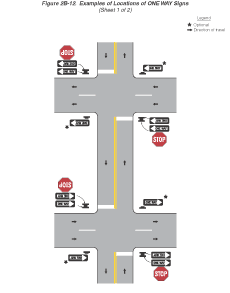
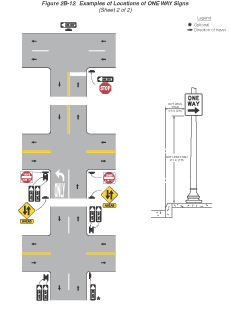
Figure 2B-13 Examples of ONE WAY Signing for Divided Highways with Medians of 9 m (30 ft) or Greater

Figure 2B-14 Examples of ONE WAY Signing for Divided Highways with Medians Less Than 9 m (30 ft)
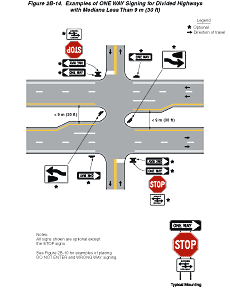
Figure 2B-15 Examples of ONE WAY Signing for Divided Highways with Medians Less Than 9 m (30 ft) and Separated Left-Turn Lanes
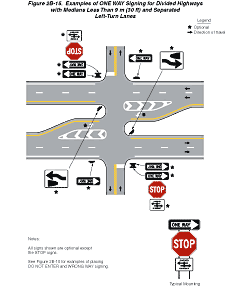
Guidance:
Where divided highways are separated by median widths at the intersection
itself of 9 m (30 ft) or more, ONE WAY signs should be placed, visible
to each crossroad approach, on the near right and far left corners
of each intersection with the directional roadways as shown in Figures
2B-12 and 2B-13.
Option:
ONE WAY signs may be omitted on the one-way roadways of divided
highways, where the design of interchanges indicates the direction
of traffic on the separate roadways.
ONE WAY signs may be omitted (see Figure 2B-14) at intersections with divided highways that have median widths at the intersection itself of less than 9 m (30 ft).
Standard:
At unsignalized intersections, ONE WAY signs shall be placed on
the near right and the far left corners of the intersection facing
traffic entering or crossing the one-way street.
At signalized intersections, ONE WAY signs shall be placed either near the appropriate signal faces, on the poles holding the traffic signals, on the mast arm or span wire holding the signals, or at the locations specified for unsignalized intersections.
Section 2B.38 Divided Highway Crossing Signs (R6-3, R6-3a)
Option:
The Divided Highway Crossing (R6-3 or R6-3a) sign (see Figure
2B-11) may be used to advise road users that they are approaching
an intersection with a divided highway.
Standard:
When the Divided Highway Crossing sign is used at a four-legged
intersection, the R6-3 sign shall be used. When used at a T-intersection,
the R6-3a sign shall be used.
Option:
The Divided Highway Crossing sign may be located on the near right
corner of the intersection and may be mounted beneath a STOP or
YIELD sign or on a separate support.
Section 2B.39 Parking, Standing, and Stopping Signs (R7 and R8 Series)
Support:
Signs governing the parking, stopping, and standing of vehicles
cover a wide variety of regulations, and only general guidance can
be provided here. The word "standing" when used on the
R7 and R8 series of signs refers to the practice of a driver keeping
the vehicle in a stationary position while continuing to occupy
the vehicle. Typical examples of parking, stopping, and standing
signs (see Figures 2B-16 and 2B-17) are as follows:
- NO PARKING ANY TIME (R7-1);
- NO PARKING 8:30 AM TO 5:30 PM (R7-2);
- NO PARKING EXCEPT SUNDAYS AND HOLIDAYS (R7-3);
- NO STANDING ANY TIME (R7-4);
- ONE HOUR PARKING 9 AM-7 PM (R7-5);
- NO PARKING LOADING ZONE (R7-6);
- NO PARKING BUS STOP (R7-7, R7-107, R7-107a);
- RESERVED PARKING for persons with disabilities (R7-8);
- NO PARKING ON PAVEMENT (R8-1);
- NO PARKING EXCEPT ON SHOULDER (R8-2);
- NO PARKING (R8-3);
- No Parking (R8-3a); and
- NO STOPPING ON PAVEMENT (R8-5).
Figure 2B-16 No Parking Signs (R7 Series)
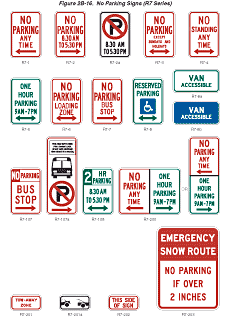
Figure 2B-17 No Parking Signs (R8 Series)
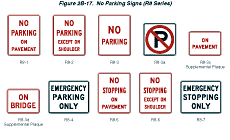
Section 2B.40 Design of Parking, Standing, and Stopping Signs
Support:
Discussions of parking signs and parking regulations in this Section
apply not only to parking, but also to standing and stopping.
Standard:
The legend on parking signs shall state applicable regulations.
Parking signs shall conform to the standards of shape, color, and
location.
Where parking is prohibited at all times or at specific times, the basic design for parking signs shall have a red legend and border on a white background (Parking Prohibition signs). Where only limited-time parking or parking in a particular manner are permitted, the signs shall have a green legend and border on a white background (Permissive Parking signs).
Guidance:
Parking signs should display the following information from top
to bottom of the sign, in the order listed:
- The restriction or prohibition;
- The times of the day that it is applicable, if not at all hours; and
- The days of the week that it is applicable, if not every day.
If the parking restriction applies to a limited area or zone, the limits of the restriction should be shown by arrows or supplemental plaques. If arrows are used and if the sign is at the end of a parking zone, there should be a single-headed arrow pointing in the direction that the regulation is in effect. If the sign is at an intermediate point in a zone, there should be a double-headed arrow pointing both ways. When a single sign is used at the transition point between two parking zones, it should display a right and left arrow pointing in the direction that the respective restrictions apply.
Where special parking restrictions are imposed during heavy snowfall, Snow Emergency signs should be installed. The legend will vary according to the regulations, but the signs should be vertical rectangles, having a white background with the upper part of the plate a red background.
When used to direct drivers to van-accessible parking facilities, a VAN ACCESSIBLE (R7-8a) plaque (see Figure 2B-16) plaque should be mounted below the D4-1 sign. Where parking spaces that are reserved for persons with disabilites are designated to accommodate wheelchair vans, a VAN ACCESSIBLE (R7-8b) plaque (see Figure 2B-16) should be mounted below the R7-8 sign.
Option:
To minimize the number of parking signs, blanket regulations that
apply to a given district may, if legal, be posted at district boundary
lines.
As an alternate to the use of arrows to show designated restriction zones, word messages such as BEGIN, END, HERE TO CORNER, HERE TO ALLEY, THIS SIDE OF SIGN, or BETWEEN SIGNS may be used.
Where parking is prohibited during certain hours and time-limited parking or parking in a particular manner is permitted during certain other time periods, the red Parking Prohibition and green Permissive Parking signs may be designed as follows:
- Two 300 x 450 mm (12 x 18 in) parking signs may be used with the red Parking Prohibition sign installed above or to the left of the green Permissive Parking sign; or
- The red Parking Prohibition sign and the green Permissive Parking sign may be combined to form an R7-200 sign on a single 600 x 450 mm (24 x 18 in) sign, or on a single 300 x 750 mm (12 x 30 in) sign.
At the transition point between two parking zones, a single sign or two signs mounted side by side may be used.
The words NO PARKING may be used as an alternative to the No Parking symbol. The supplemental educational plaque, NO PARKING, with a red legend and border on a white background, may be used above signs incorporating the No Parking symbol.
Alternate designs for the R7-107 sign may be developed such as the R7-107a sign (see Figure 2B-16). Alternate designs may include, on a single panel, a transit logo, an approved bus symbol, a parking prohibition, the words BUS STOP, and an arrow. The preferred bus symbol color is black, but other dark colors may be used. Additionally, the transit logo may be shown on the bus face in the appropriate colors instead of placing the logo separately. The reverse side of the sign may contain bus routing information.
To make the parking regulations more effective and to improve public relations by giving a definite warning, a sign (see Figure 2B-16) reading TOW-AWAY ZONE (R7-201) may be appended to, or incorporated in, any parking prohibition sign. The Tow-Away Zone (R7-201a) symbol sign may be used instead of the R7-201 word message sign. The R7-201a sign may have either a black or red legend and border on a white background.
In rural areas, the legend NO PARKING ON PAVEMENT (R8-1) is generally suitable and may be used. If a roadway has paved shoulders, the NO PARKING EXCEPT ON SHOULDER sign (R8-2) may be used as it is less likely to cause confusion. The R8-3a symbol sign or the word message NO PARKING (R8-3) sign may be used to prohibit any parking along a given highway. Word message supplemental plaques (see Figure 2B-17), such as ON PAVEMENT (R8-3c) or ON BRIDGE (R8-3d), may be mounted below the R8-3 or R8-3a sign.
Section 2B.41 Placement of Parking, Stopping, and Standing Signs
Guidance:
When signs with arrows are used to indicate the extent of the restricted
zones, the signs should be set at an angle of not less than 30 degrees
nor more than 45 degrees with the line of traffic flow in order
to be visible to approaching traffic.
Spacing of signs should be based on legibility and sign orientation.
If the zone is unusually long, signs showing a double arrow should be used at intermediate points within the zone.
Standard:
If the signs are mounted at an angle of 90 degrees to the curb line,
two signs shall be mounted back to back at the transition point
between two parking zones, each with the appended message THIS SIDE
OF SIGN.
Guidance:
At intermediate points within a zone, a single sign without any
arrow or appended plaque should be used, facing in the direction
of approaching traffic. Otherwise the standards of placement should
be the same as for signs using directional arrows.
Section 2B.42 Emergency Restriction Signs (R8-4, R8-7, R8-8)
Option:
The EMERGENCY PARKING ONLY (R8-4) sign (see Figure 2B-17) or the
EMERGENCY STOPPING ONLY (R8-7) sign (see Figure 2B-17) may be used
to discourage or prohibit shoulder parking, particularly where scenic
or other attractions create a tendency for road users to stop temporarily,
even though turnout or rest areas have not been provided.
The DO NOT STOP ON TRACKS (R8-8) sign (see Figure 8B-3) may be used to discourage or prohibit parking or stopping on railroad tracks (see Section 8B.07).
Standard:
Emergency Restriction signs shall be rectangular and shall have
a red or black legend and border on a white background.
Section 2B.43 WALK ON LEFT FACING TRAFFIC and No Hitchhiking Signs (R9-1, R9-4, R9-4a)
Option:
The WALK ON LEFT FACING TRAFFIC (R9-1) sign (see Figure 2B-18) may
be used on highways where no sidewalks are provided.
Standard:
If used, the WALK ON LEFT FACING TRAFFIC sign shall be installed
on the right side of the road where pedestrians walk on the pavement
or shoulder in the absence of pedestrian pathways or sidewalks.
Option:
The No Hitchhiking (R9-4a) sign (see Figure 2B-18) may be used to
prohibit standing in or adjacent to the roadway for the purpose
of soliciting a ride. The R9-4 word message sign (see Figure 2B-18)
may be used as an alternate to the R9-4a symbol sign.
Figure 2B-18 Pedestrian Signs
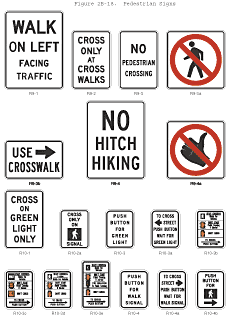
Section 2B.44 Pedestrian Crossing Signs (R9-2, R9-3)
Option:
Pedestrian Crossing signs (see Figure 2B-18) may be used to limit
pedestrian crossing to specific locations.
Standard:
If used, Pedestrian Crossing signs shall be installed to face pedestrian
approaches.
Option:
Where crosswalks are clearly defined, the CROSS ONLY AT CROSSWALKS
(R9-2) sign may be used to discourage jaywalking or unauthorized
crossing.
The No Pedestrian Crossing (R9-3a) sign may be used to prohibit pedestrians from crossing a roadway at an undesirable location or in front of a school or other public building where a crossing is not designated.
The NO PEDESTRIAN CROSSING (R9-3) word message sign may be used as an alternate to the R9-3a symbol sign. The USE CROSSWALK (R9-3b) supplemental plaque, along with an arrow, may be installed below either sign to designate the direction of the crossing.
Support:
One of the most frequent uses of the Pedestrian Crossing signs is
at signalized intersections that have three crossings that can be
used and one leg that cannot be crossed.
Guidance:
The R9-3b sign should not be installed in combination with educational
plaques.
Section 2B.45 Traffic Signal Signs (R10-1 through R10-21)
Option:
To supplement traffic signal control, Traffic Signal signs R10-1
through R10-21 may be used to regulate road users.
Guidance:
When used, Traffic Signal signs should be located adjacent to the
signal face to which they apply.
Standard:
Traffic Signal signs applicable to pedestrian actuation (see Figure
2B-18) shall be mounted immediately above or incorporated in
pedestrian pushbutton units (see Section
4E.08).
Support:
Traffic Signal signs applicable to pedestrians include:
- CROSS ON GREEN LIGHT ONLY (R10-1);
- CROSS ON WALK SIGNAL ONLY (R10-2);
- PUSH BUTTON FOR GREEN LIGHT (R10-3); and
- PUSH BUTTON FOR WALK SIGNAL (R10-4).
Option:
The following signs may be used as an alternate for the R10-3 and
R10-4 signs:
- TO CROSS STREET (arrow), PUSH BUTTON WAIT FOR GREEN LIGHT (R10-3a); and
- TO CROSS STREET (arrow), PUSH BUTTON WAIT FOR WALK SIGNAL (R10-4a).
The symbol sign R10-2a may be used as an alternate to sign R10-2. Where symbol-type pedestrian signal indications are used, an educational sign (R10-3b) may be used to improve pedestrian understanding of pedestrian indications at signalized intersections. Where word-type pedestrian signal indications are being retained for the remainder of their useful service life, the legends WALK/DONT WALK may be substituted for the symbols on the educational sign R10-3b, thus creating sign R10-3c. The R10-3d sign may be used if the pedestrian clearance time is sufficient only for the pedestrian to cross to the median. The diagrammatic sign R10-4b may also be used as an alternate to sign R10-4. At intersections where pedestrians cross in two stages using a median refuge island, the word message "CROSS TO MEDIAN" may be placed on the near corner of the refuge island along with the educational plaque.
Traffic Signal signs (see Figure 2B-19) may be installed at certain locations to clarify signal control. Among the legends for this purpose are LEFT ON GREEN ARROW ONLY (R10-5), STOP HERE ON RED (R10-6 or R10-6a) for observance of stop lines, DO NOT BLOCK INTERSECTION (R10-7) for avoidance of traffic obstructions, USE LANE(S) WITH GREEN ARROW (R10-8) for obedience to Lane Control signals, LEFT TURN YIELD ON GREEN (symbolic green ball) (R10-12), and LEFT TURN SIGNAL YIELD ON GREEN (symbolic green ball) (R10-21) (see Section 4D.06).
In situations where traffic control signals are coordinated for progressive timing, the Traffic Signal Speed (I1-1) sign may be used (see Section 2D.47).
Standard:
The NO TURN ON RED (R10-11a, R10-11b) sign (see Figure 2B-19) shall
be used to prohibit a right turn on red (or a left turn on red from
a one-way street to a one-way street).
Figure 2B-19 Traffic Signal Signs
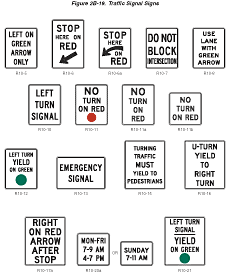
Option:
A symbolic NO TURN ON RED (R10-11) sign (see Figure 2B-19) may be
used as an alternate to the R10-11a and R10-11b signs.
Guidance:
If used, the NO TURN ON RED sign should be installed near the appropriate
signal head.
A NO TURN ON RED sign should be considered when an engineering study finds that one or more of the following conditions exists:
- Inadequate sight distance to vehicles approaching from the left (or right, if applicable);
- Geometrics or operational characteristics of the intersection that might result in unexpected conflicts;
- An exclusive pedestrian phase;
- An unacceptable number of pedestrian conflicts with right-turn-on-red maneuvers, especially involving children, older pedestrians, or persons with disabilities; and
- More than three right-turn-on-red accidents reported in a 12-month period for the particular approach.
Where turns on red are permitted and the signal indication is a RED ARROW, the RIGHT (LEFT) ON RED ARROW AFTER STOP (R10-17a) sign (see Figure 2B-19) should be installed adjacent to the RED ARROW signal indication.
Option:
In order to remind drivers who are making turns to yield to pedestrians,
especially at intersections where right turn on red is permitted
and pedestrian crosswalks are marked, a TURNING TRAFFIC MUST YIELD
TO PEDESTRIANS (R10-15) sign may be used (see Figure 2B-19).
A supplemental R10-20a plaque (see Figure 2B-19) showing times of day (similar to the S4-1 plaque shown in Figure 7B-1) with a black legend and border on a white background may be mounted below a NO TURN ON RED sign to indicate that the restriction is in place only during certain times.
Standard:
The EMERGENCY SIGNAL (R10-13) sign (see Figure 2B-19) shall be used
in conjunction with emergency-vehicle traffic control signals (see
Section 4F.02).
Option:
A U-TURN YIELD TO RIGHT TURN (R10-16) sign (see Figure 2B-19) may
be installed near the left-turn signal face if U-turns are allowed
on a protected left-turn movement on an approach from which drivers
making a right turn from the conflicting approach to their left
are simultaneously being shown a right-turn GREEN ARROW signal indication.
Section 2B.46 Photo Enforced Signs (R10-18, R10-19)
Option:
A TRAFFIC LAWS PHOTO ENFORCED (R10-18) sign (see Figure
2B-1) may be installed at a jurisdictional boundary to advise
road users that some of the traffic regulations within that jurisdiction
are being enforced by photographic equipment.
A PHOTO ENFORCED (R10-19) sign (see Figure 2B-1) may be mounted below a regulatory sign to advise road users that the regulation is being enforced by photographic equipment.
Standard:
If used below a regulatory sign, the PHOTO ENFORCED (R10-19) sign
shall be a rectangle with a black legend and border on a white background.
Section 2B.47 KEEP OFF MEDIAN Sign (R11-1)
Option:
The KEEP OFF MEDIAN (R11-1) sign (see Figure 2B-20) may be used
to prohibit driving into or parking on the median.
Guidance:
The KEEP OFF MEDIAN sign should be installed on the left of the
roadway within the median at random intervals as needed wherever
there is a tendency for encroachment.
Figure 2B-20 Road Closed and Weight Limit Signs
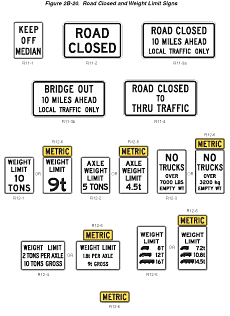
Section 2B.48 ROAD CLOSED Sign (R11-2) and LOCAL TRAFFIC ONLY Signs (R11-3 Series, R11-4)
Guidance:
The ROAD CLOSED (R11-2) sign should be installed where roads have
been closed to all traffic (except authorized vehicles).
ROAD CLOSED—LOCAL TRAFFIC ONLY (R11-3) or ROAD CLOSED TO THRU TRAFFIC (R11-4) signs should be used where through traffic is not permitted, or for a closure some distance beyond the sign, but where the highway is open for local traffic up to the point of closure.
Standard:
The Road Closed (R11-2, R11-3 series, and R11-4) signs (see Figure
2B-20) shall be designed as horizontal rectangles. These signs shall
be preceded by the applicable Advance Road Closed warning sign with
the secondary legend AHEAD and, if applicable, an Advance Detour
warning sign (see Section
6F.18).
Option:
The word message BRIDGE OUT may be substituted for the ROAD CLOSED
message where applicable.
